|
As it first appeared published in "Harlot's Sauce" June 29th, 2010 After the birth of my son in 2007, I felt an incredible energy and drive to make art. Contrary to the popular belief that art-making is one of the things that fall to the wayside after the birth of children, I felt not just inspired but compelled by my experience of childbirth and motherhood. The creative act of making another human being awoke a creative drive in me. I also found that the time limitations involved in caring for an infant forced me to be more disciplined, eking out an hour here and there when my son was sleeping to continue my portraits. After my daughter’s birth in 2008, I embarked on a series of mother and child portraits accompanied by birth stories written by each subject. I wanted to simultaneously express the imperfection and fallibility of the mothers and capture an element of the divine in the mother/child bond. Each mother in the series shares her birth story—life-changing, beautiful, or harrowing—and these experiences unify a very diverse group with a common theme: love, self sacrifice and transcendence. The inspiration for this project is my children: their beauty, their challenges and the unique and universal bond of motherhood. 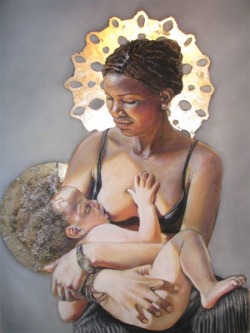 Each portrait is done in ‘conte crayon’ (semi hard pastel,) accented with a gold leaf halo in an echo of portraits of the Virgin Mary with child (Madonna Lactans) from the 15th century, as well as an early 20th century revival of the practice by such artists as William Adolphe Bouguereau. Working out the process of creating the haloes was complicated. I outlined the circular shapes and filled them in with the leaf in the first four portraits, then devised a way to make a pattern in the halo with “Gladys and Elizabeth.” I was thinking of rose windows, and wracking my brain for a way to make such an even pattern by hand with my limited math skills. Unable to think of anything, I set the problem aside and started cutting out snowflakes with my son instead. Then it occurred to me to cut an elaborate snowflake and use the radiating design for the halo. I outlined a snowflake pattern on each halo and painted the gold leaf sizing on to the ground of the pattern, but not the holes, waited for the sizing to dry, and then rubbed the un-sized leaf off to reveal the pattern. Three of my portraits are of mothers breastfeeding their babies. These modern Madonnas Lactans are a true celebration of motherhood. Breastfeeding can be a challenge. Many women did not witness their mothers breastfeeding and are unsure of how to do it correctly, and many are unnerved by the social stigma surrounding breastfeeding in public. The simple act of successfully breastfeeding their babies is a true victory. For me, there is an aura of joy, bliss and awe surrounding a breastfeeding mother, as she seems to embody the fundamental divinity of motherhood, the Gaia and the Virgin Mary. I personally find breastfeeding mothers so beautiful and pure that I was unprepared for the reaction my portraits generated when I posted them on the popular networking website Facebook. I posted one on a figurative artists group on Facebook, and was surprised to see that it had been removed on March 27th, 2010, just a few days later. I had already posted two more portraits, so I went ahead and reposted the one in question, thinking it must have been a glitch. My new artwork was removed on March 28th, and then on March 29th the re-posted portrait was removed as well. I reposted all three in a row, as a kind of experiment, and received the following letter by email:  Hello, You posted an item that violated our Terms of Use, and this item has been removed. Among other things, content that is hateful, threatening, or obscene is not allowed, nor is content that attacks an individual or group. Continued misuse of Facebook’s features could result in your account being disabled. If you have any questions or concerns, you can contact us at warning@facebook.com from your login email address. The Facebook Team I went to the local CBC radio station, and was featured on the CBC Radio One morning show “On The Island” with Gregor Craigie, (go to April 9th podcast, I'm at about 7:38 in the program.) After that, the story took on a life of its own. It was covered by various CBC broadcasts, a CBC television news program in Saskatoon, CBC Radio One’s “The Story from Here,” with Sheila Coles, (listen to part two of June 23rd 2010,) CHEK-TV News in Victoria, two talk radio shows in Toronto and Montreal, the front page of the local Comox Valley Record and an article by Antonia Zerbisias in the Toronto Star. I believe that Facebook’s treatment of my breastfeeding portraits is indicative of the brutally high expectations that society holds for mothers. Mothers are expected to breastfeed, every health organization tells us it’s the best choice, yet images of women breastfeeding are labelled obscene and mothers are treated with hostility and disdain when breastfeeding in public. The result is an ideal of motherhood that no mother could possibly meet: scolded if we don’t nourish our babies exactly the way they tell us to, shamed if we dare to do it in public or celebrate and honour the unique bond it creates. A common theme throughout many of the birth stories was a sense of inadequacy. Many women felt they had not lived up to their ideal of what a mother should be, what a birth should be. There was often a sense of loneliness, as in the story of Gladys and Elizabeth. Gladys came to Canada with her Canadian husband and gave birth far away from her native Kenya, in the dead of winter. Many of us, myself included, wished to have a natural birth, and had to settle for a c section birth instead. For some women it was elating to give birth naturally after a previous c section, proving to themselves that they were capable of giving birth. For everyone the act of childbirth was a rite of passage, a moment in our lives right before motherhood, when everything changes, even one’s sense of self. I wanted to draw parallels between our own ideals of what a mother should be, and the cultural ideal of motherhood, symbolized by the Virgin Mary. I wanted to simultaneously honour both that ideal and actual motherhood in all the glory of its imperfection. My biggest issue with the Facebook censorship was that it was selective. The artwork posted on the figurative and portrait site includes many (wonderful) full nudes, while none of my portraits show more than a two-piece bathing suit would. I can only conclude that it is not the amount of bare flesh, but the subject matter of my work that they find offensive, and I find that abhorrent. Breastfeeding is not obscene. If you wish to take part in an online petition, please join my Facebook group: “Hey Facebook! Breastfeeding artwork is not obscene!”
2 Comments
"Couldn't she have done it in the car on the way there?" That comment was probably the worst from Lisa of the Russ and Lisa Morning Show after witnessing a woman breastfeeding her baby at a Chick Fill A restaurant in Greenville, South Carolina. She seems to be suggesting we take our babies out of their carseats and put them in the front seat of the car with us, risking that they might fly through the window in the event of an accident... all to spare someone the discomfort of witnessing them feed in a restaurant. She also said "why isn't this indecent exposure? I think there should be indecency laws." Perhaps we should make it public indecency, on par with exposing one's genitals in a restaurant, then hire a special division of the police force... let's call them the Boob Squad. They can keep all the women and children in line. She suggested that her views might have something to do with the way she was raised, that someone with more traditional values might be more discreet than to nurse in public. She also suggested women stay at home rather than expose the public to an "intimate moment" like breastfeeding. Her suggestion implies that a breastfeeding mothers in the past would have to stay at home rather than participate in public life. Certainly this would be their only option, before formula was widely available... She suggested mothers come prepared, pump and bring a bottle rather than breastfeed. She told one caller that pumping is no more difficult than preparing a bottle of formula and bringing it to the restaurant. One caller commented that "If you wouldn't do it in the front pew of a church, then don't do it in a restaurant." What about this church? Surely the mother of God might object if you didn't use a bottle, come prepared as she suggested. Jesus himself would certainly object to public breastfeeding, wouldn't he? What Lisa fails to realize is that bottle feeding as a conservative value is actually fairly recent. Women never used to feel shame at public breastfeeding, nor were they pressured by their communities to keep "such an intimate act" private. Breastfeeding was considered to be quite matter of fact most of the time, and rather beautiful and womanly some of the time. It wasn't equated with sexuality as it is now, or else we would never see an icon of the Virgin Mary breastfeeding
in public in a church. Or perhaps she's suggesting that the mother of God was a little loose in her morals? 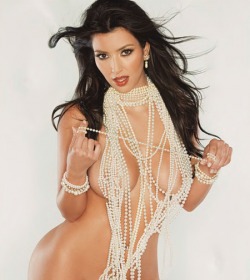 Yesterday afternoon I received an interesting tweet from @KimKardashian "EWW Im at lunch,the woman at the table next 2 me is breast feeding her baby w no coverup then puts baby on the table and changes her diaper" Apparently later she did a follow up tweet saying: "My sister breastfeeds! It's a natural beautiful thing, there's nothing wrong w it, but she covers herself, not w her boobs exposed." Thank you for the lesson in modesty, dear Kim. I will be sure to cover myself whenever nursing in public from now on. First of all the irony of the statement is obvious- she posed for Playboy! How could she be so prudish about a little bit of boob exposed in the act of nursing! It was funny. And also very very sad. I find it disturbing how vicious women can be to one another. When I had an article published in the Toronto Star on the subject of the censorship of my art from Facebook http://www.thestar.com/living/article/794323--are-these-obscene?bn=1 some of the nastiest attacks in the reader comments were from other women; the worst being the following statement: "As a mother of 2, trust me, others are not interested in seeing your bloated breasts from pregnancy. And another newsflash, they ain't gonna last!" It's unfortunate for Kim that she made a statement like she did, because she is the classic Glass House that shouldn't throw stones. It would be so easy to attack her, point out her hypocricy, insult her figure... that is partly why I feel sad about her comments. Let's instead take a step back and see her as a product of her society. This is precisely what is wrong with society's view of breasts today. Women are taught to see themselves as sexual objects first, with breastfeeding being a secondary function. There is a de-humanizing quality to this, as women are detached from their own biology, their relationships to others, their needs and desires, and put in a realm of pure asthetics. Women are not judged for the content of their character, but merely for the quality of their skin.
It's also unfortunate for the many many young women who follow her tweets. The breastfeeding statistics for young women are depressing already- something like 20% -30% of young women choose to breastfeed. Imagine how many more might be affected by this post: "EWWW! ...breastfeeding!" and choose not to give their babies the best start to life. The diservice this statement has made to the breastfeeding advocacy movement is staggering. |
A blog on art, roller derby and life.
Kate HansenI'm an artist and mother of two in Courtenay, BC. I've completed a project called the "Madonna and Child Project," and I'm now working on a series of roller derby inspired drawings. In my spare time I play roller derby with the Brick House Betties. Archives
November 2012
Categories
All
|
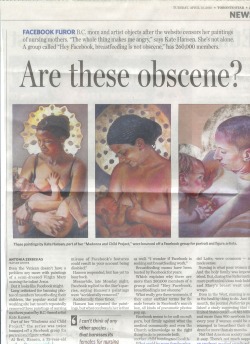
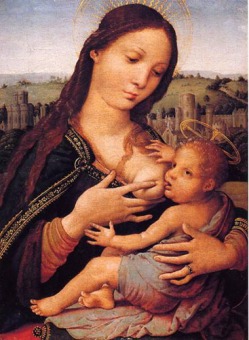
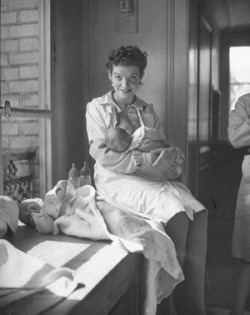
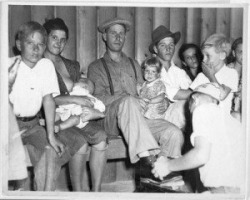


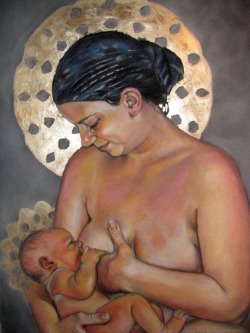
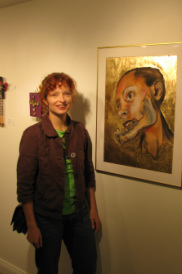

 RSS Feed
RSS Feed
